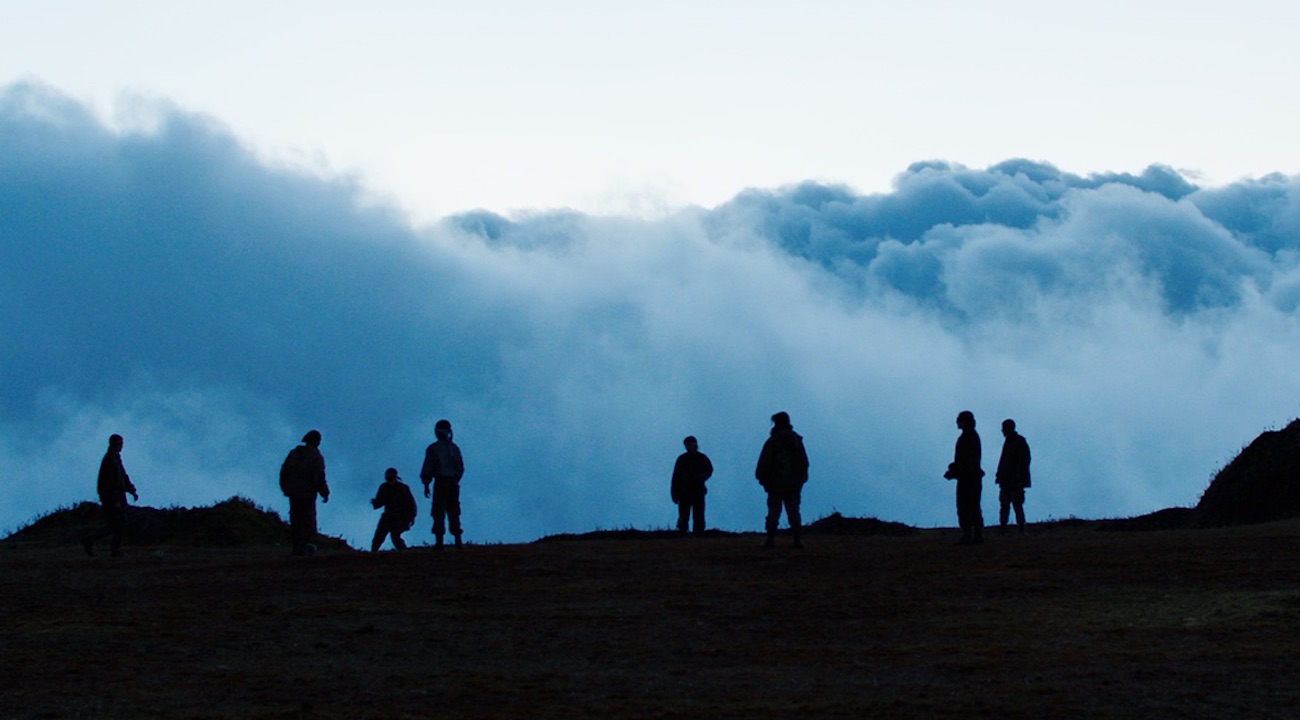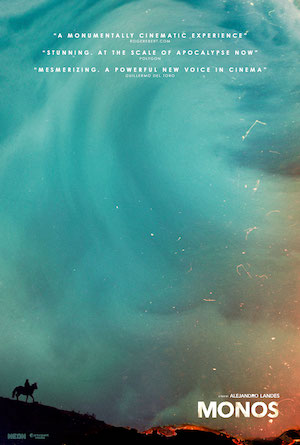 Writer/Director Alejandro Landes’ awe-inspiring third feature is a breathtaking survivalist saga set on a remote mountain in Latin America. The film tracks a young group of soldiers and rebels bearing names like Rambo, Smurf, Bigfoot, Wolf, and Boom-Boom who keep watch over an American hostage, Doctora (Julianne Nicholson) The teenage commandos perform military training exercises by day and indulge in youthful hedonism by night, an unconventional family bound together under a shadowy force known only as the Organization. After an ambush drives the squadron into the jungle, both the mission and the intricate bonds between the group begin to disintegrate. Order descends into chaos and within Monos the strong begin to prey on the weak in this vivid, cautionary fever dream.
Writer/Director Alejandro Landes’ awe-inspiring third feature is a breathtaking survivalist saga set on a remote mountain in Latin America. The film tracks a young group of soldiers and rebels bearing names like Rambo, Smurf, Bigfoot, Wolf, and Boom-Boom who keep watch over an American hostage, Doctora (Julianne Nicholson) The teenage commandos perform military training exercises by day and indulge in youthful hedonism by night, an unconventional family bound together under a shadowy force known only as the Organization. After an ambush drives the squadron into the jungle, both the mission and the intricate bonds between the group begin to disintegrate. Order descends into chaos and within Monos the strong begin to prey on the weak in this vivid, cautionary fever dream.
With a rapturous score by Mica Levi (Under the Skin, Jackie), director Alejandro Landes examines the chaos and absurdity of war from the unique perspective of adolescence, recalling Lord of the Flies and Beau Travail in a way that feels wholly original. Landes brings together a diverse young cast of both seasoned professionals (including Hannah Montana’s Moisés Arias) and untrained newcomers and thrusts them into an unforgiving, irrational, and often surreal environment where anything can happen — even peace.
I sat down with Alejandro Landes to discuss this remarkable film, winner of a Special Jury Award at the Sundance Film Festival and recently chosen by Colombia to represent the country in the Best Foreign Language Film at the upcoming Oscars.
Danny Miller: This film is a fucking masterpiece. There’s my blurb: “It’s a fucking masterpiece.”
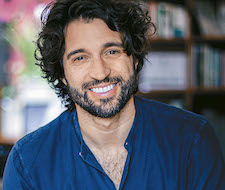
Alejandro Landes
Alejandro Landes: (Laughs.) Well, that’s a great blurb, I’ll take it! We can throw in a few asterisks on the poster: “It’s a f**king masterpiece!”
It’s pure poetry. I love the jaw-dropping beauty mixed with utter horror. I felt fully engaged with all the characters right from the get-go. How did you put together such a remarkable ensemble?
We looked at a bunch of kids from different places all over Colombia including urban skating culture and deep in the countryside. Out of the 800 kids we looked at, we chose about 25 and took them to live in a sort of mock basic training camp. In the morning, they did acting and improv exercises, and then in the afternoon they did physical training to learn how to carry a weapon, stand in formation, those types of things. By watching those 25 kids interact, I saw the dynamics that you would see like in a schoolyard — who flirts with who, who fights with who, and so on. I chose the final eight from there because the idea wasn’t just how each of them individually played their role, but what sparks would there be with them as an ensemble. That was key.
And some of them had never acted before?
Right. I mean, listen, there aren’t that many really good professional actors who are 13 or 14 anywhere, let alone in Colombia.
At least you didn’t have to weed out what American directors often call the “Disney kids.”
Oh, that’s funny, because I actually did have a real Disney kid (Moisés Arias, who starred with Miley Cyrus for four years in Hannah Montana) and he was fantastic!
Oh, right, he’s excellent! How did he end up in the film?
I just thought it was very interesting because he comes from a Colombian family and had never made a movie there. When I met him, he was really psyched about doing the character even though his team in L.A. was not, they thought this film was just crazy. But he was very enthusiastic and did the basic training with the other kids and really took it to heart. He really bonded with them.
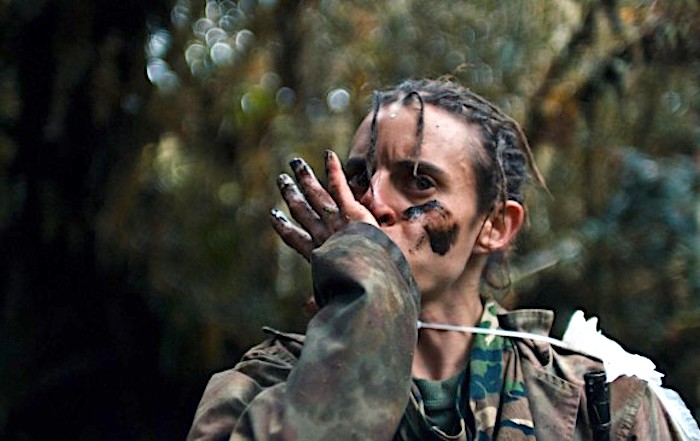
Is it ever tricky to mix professional actors with non-professionals?
I’ve heard from other directors that it’s very hard to mix the two. I can see that professional actors might be frustrated with the lack of discipline in non-actors, and the non-actors may feel intimidated by people with so much experience like Moisés and Julianne Nicholson. But luckily, our cast spent so much time together creating such strong bonds before we ever began shooting so that was never really an issue.
It probably helped that you were all together in such an isolated environment.
Yes, that’s true. But the non-actors were amazing. I’ve very proud of those moments like, for example, when Swede is able to completely hold her own with Julianne Nicholson’s Doctora in their intense scene together. I love how that scene shows the thin line between eroticism and death, between laughter and rage.
That scene was incredible. Did you end up making any script changes based on the group you ended up with?
That’s a great question, I actually did rewrite the screenplay after seeing them together. For example, when I wanted to have a romantic interest in the film, I wanted to make sure that it was between people who had real chemistry. My co-writer Alexis Dos Santos and I changed around several of the characters to make sure that we weren’t just forcing the page on the characters but letting the kids come through on the page as we got to know them better. We really needed to do that because there are so many characters. This wasn’t a typical narrative, it’s a very fluid point of view.
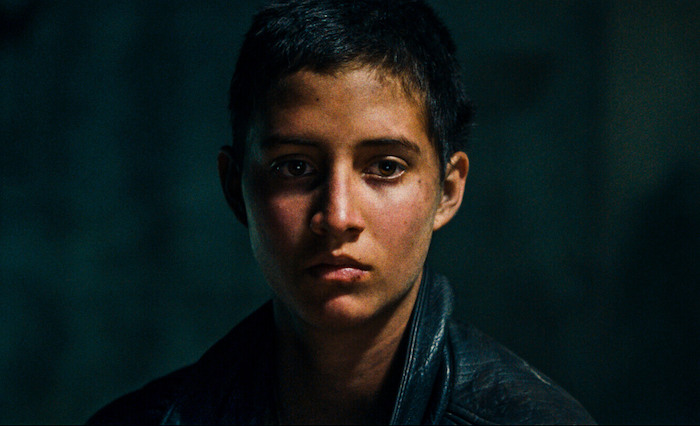
And speaking of fluidity, I have to admit that I had no idea when I first watched the film that Rambo was a girl! I knew there was some gender fluidity going on, but I was still very surprised when I discovered that later.
I actually love that there are people who experienced the entire film thinking Rambo was a boy — even some of our distributors and marketing people at first. I never wanted to have one of those “big reveals” at the end, it’s not that kind of film. It’s almost like a post-gender situation. Does it change anyone’s deeper impressions of the film? I don’t think so.
I remember the scene when Rambo kisses Wolf and thinking that the homoeroticism of that scene was interesting but then it turns out that’s not the case and it’s more about the freedom these kids feel in that environment.
The bigger idea wasn’t just about gender, it was about denying the audience any type of binary conception of anything. Are you in the past or in the future? Are these people good or bad? Are they communists fighting for the left or are they extreme radicals fighting for the right? Is this character a boy or girl? Is this paradise or some kind of hell? The film doesn’t allow you to label them one thing or the other, including Julianne’s character who starts out very much like a victim but then feels like something very different at the end.
There were so many moments that didn’t go the way I thought they would. Was it always your intention to keep the identity and the political leanings of the Organization vague?
Yes. The thing is, I read so much about all of these different types of organizations and the bottom line is that they’re not so different from each other. I come from a country where you have paramilitary organizations, guerrilla organizations, narco organizations, you have foreign actors, you have state actors, and there are all these different fronts in these battles because it’s been going on for so long.
Plus, when you have kids engaged in such conflicts, is it ever really about ideology?
Absolutely, that’s a very good point. When you see these groups in Colombia that are working with children who were involved in such groups trying to re-insert them into society, you see some who fought for Communists and rebels and some who fought for ultra-right-wing groups and some who had fought for both. These kids were not exactly sitting in the trenches debating Karl Marx.
And who knows what they were escaping from in their own lives or if they were there totally against their will.
Right. Which is why I try to show something of the beginning at the end. Remember that 360-degree shot where we see the newly orphaned kids hiding under the table? That scene really hits me, it kind of says it all. What’s going to happen to these kids? Where are they going to go? Are they going to end up in this group? There are so many moments like that. I remember when Doctora is trying to get free by bonding with Swede. She asks her what she wants to do with her life, saying that she could help her, and Swede says, “I want to dance on TV.”
So poignant.
I wanted to come at Julianne’s character, Doctora, through the humanity of her situation. It didn’t matter to me what she was doing in Colombia when she was captured or what the ideology of the group who captured her is.
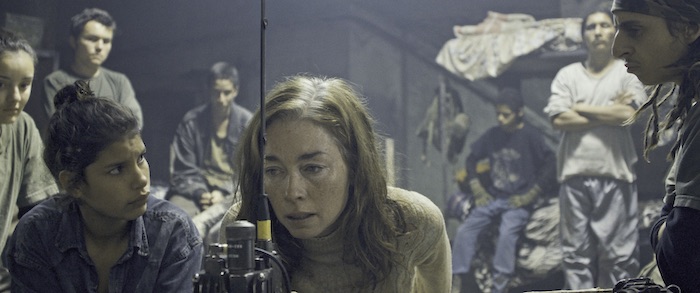
Did you find the reactions to the film were different in Colombia compared to what you’re seeing here?
The response has been fascinating because there are such delicate fibers when you have a civil war that’s been going on for more than 60 years.
Do the audiences there have more of a vested interest in knowing which side this group is on in the conflict?
It’s interesting because the critics wanted to know, but the audiences were fine with the ambiguity. For me this is not a film about child soldiers. I mean, I think everyone agrees that children should not be part of war, but I was interested in pushing that further. I wanted to examine that period between childhood and adulthood, that borderline that can often be very conflicted even if you’re just a normal kid on the first day of school who is undergoing all these changes. I think this film creates a kind of mirror between those two conflicts: the war that is present in the world and the interior wars these kids are going through. Who am I? Who do I want to be? Adolescence can be a very intense period that is full of trauma.
Definitely. And thank God most of us don’t have AK-47s in our hands when we’re going through it! Apart from the horror that we see on screen, this is still one of the most visually beautifully films I’ve ever seen. The location is just gorgeous but I imagine that it must have been extremely difficult to shoot there.
Oh God, making this movie was a real beast. We were 14,000 feet up in the mountains where there is very little oxygen in the air and the weather can change on a dime so you can’t really follow a strict shooting plan. Just to get to that jungle canyon you need mules and kayaks. It was very tough. I would say that every person was at the limit of what they could do physically. Pretty much everyone had their day on a stretcher or in an ambulance. I had mine, but somehow we managed to keep it together.
You never had one of the kids come up to you and say, “I just can’t do this anymore?”
Never. But we all cried at some point during the filming.
Those emotions were probably beneficial for the scenes you were shooting.
Everyone was really giving it their all. They felt infused with confidence which was amazing to see. Sometimes the kids would come up to me and ask if they could do a scene over again, that they felt that they could do better, even when I liked the take. I don’t think I’ve ever seen a more devoted group of people making a film under such difficult conditions.

